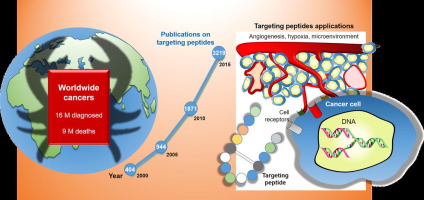Bioorganic & Medicinal Chemistry ( IF 3.5 ) Pub Date : 2017-09-01 , DOI: 10.1016/j.bmc.2017.08.052 Vadim Le Joncour , Pirjo Laakkonen

|
Accounting for 16 million new cases and 9 million deaths annually, cancer leaves a great number of patients helpless. It is a complex disease and still a major challenge for the scientific and medical communities. The efficacy of conventional chemotherapies is often poor and patients suffer from off-target effects. Each neoplasm exhibits molecular signatures – sometimes in a patient specific manner – that may completely differ from the organ of origin, may be expressed in markedly higher amounts and/or in different location compared to the normal tissue. Although adding layers of complexity in the understanding of cancer biology, this cancer-specific signature provides an opportunity to develop targeting agents for early detection, diagnosis, and therapeutics. Chimeric antibodies, recombinant proteins or synthetic polypeptides have emerged as excellent candidates for specific homing to peripheral and central nervous system cancers. Specifically, peptide ligands benefit from their small size, easy and affordable production, high specificity, and remarkable flexibility regarding their sequence and conjugation possibilities. Coupled to imaging agents, chemotherapies and/or nanocarriers they have shown to increase the on-site delivery, thus allowing better tumor mass contouring in imaging and increased efficacy of the chemotherapies associated with reduced adverse effects. Therefore, some of the peptides alone or in combination have been tested in clinical trials to treat patients. Peptides have been well-tolerated and shown absence of toxicity. This review aims to offer a view on tumor targeting peptides that are either derived from natural peptide ligands or identified using phage display screening. We also include examples of peptides targeting the high-grade malignant tumors of the central nervous system as an example of the complex therapeutic management due to the tumor’s location. Peptide vaccines are outside of the scope of this review.
中文翻译:

寻求并销毁,使用靶向肽进行癌症检测和药物递送
癌症每年导致1600万新病例和900万死亡,使许多患者无奈。它是一种复杂的疾病,仍然是科学和医学界面临的主要挑战。常规化学疗法的疗效通常较差,并且患者会遭受脱靶效应的困扰。每个肿瘤都表现出分子特征(有时以患者特定的方式),可能与起源器官完全不同,与正常组织相比,其表达量和/或位置明显不同。尽管增加了对癌症生物学理解的复杂性,但这种特定于癌症的特征为开发用于早期检测,诊断和治疗的靶向剂提供了机会。嵌合抗体,重组蛋白或合成多肽已成为针对外周和中枢神经系统癌症的特异性归巢的优秀候选者。特别地,肽配体得益于其体积小,容易和可负担的生产,高特异性以及就其序列和缀合可能性而言的显着灵活性。已显示它们与显像剂,化学疗法和/或纳米载体耦合,可以增加现场递送,从而在成像中实现更好的肿瘤块轮廓,并提高与降低的不良反应相关的化学疗法的功效。因此,一些单独或组合的肽已在临床试验中测试过以治疗患者。肽具有良好的耐受性,并且没有毒性。这篇综述旨在提供有关肿瘤靶向肽的看法,所述肿瘤靶向肽要么衍生自天然肽配体,要么使用噬菌体展示筛选进行鉴定。我们还包括针对中枢神经系统恶性恶性肿瘤的肽类实例,作为由于肿瘤位置而进行复杂治疗的实例。肽疫苗不在本综述范围内。



























 京公网安备 11010802027423号
京公网安备 11010802027423号